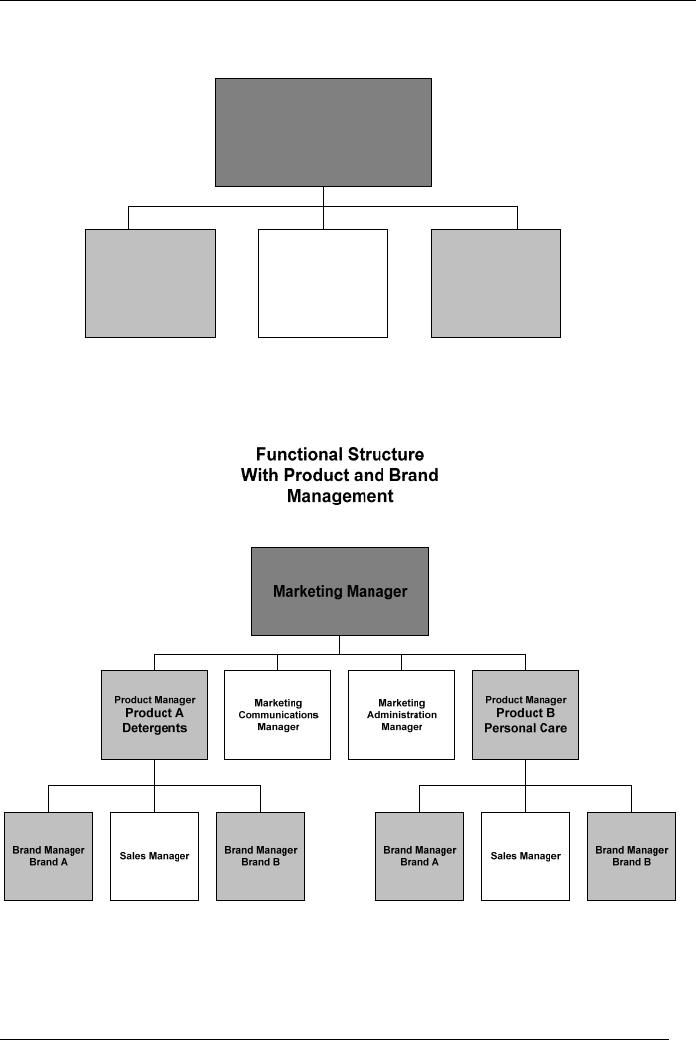 |
UNDERSTANDING BRANDS – INTRODUCTION:Functions of Brand Management, Sales forecast, Brand plan |
| INTRODUCTION:Brand Value and Power, Generate Profits and Build Brand Equity >> |

Brand
Management (MKT624)
VU
Lesson
1
UNDERSTANDING
BRANDS INTRODUCTION
Brand
management as one of the marketing
functions has been around
for as long as we
have
known
professional marketing.
But,
it has been a part of the
traditional marketing approach in which
many functions of
today's
brand
management were performed in a spread
out fashion by the marketing
manager and a
combination
of his team members like the
sales manager, the
advertising and communications
manager,
and the marketing administration manager
to name a few. The terminology of
brand
management
was not used.
Brand
management, in its present integrated
form, has come into
limelight and focus over
the
last
20 years. The functional execution
has undergone transformation in
terms of its
description
as
a substantive job under one
head. This implies that
the overall functions of
brand
management
are full of substance and therefore
are described specifically
under the head -
brand
management and not as disparate parts of
the overall marketing
functions.
In
other words, brand management
has not lost its
primary roots that are
well-entrenched in
marketing;
it only has acquired
explicitly defined dimensions
within which the
function
operates.
To
further elucidate the point,
there have been functional
adjustments within the
overall
marketing
functions only to bring into
clear and sharp focus the
specific functions and job
of
brand
management.
Brand
management now presents itself as a
distinct part of an integrated
marketing approach in
which
it connects with all the
touch points within and
outside of the marketing
department.
The
whole concept can be exemplified by
seeking your attention toward
two fruit baskets;
one
full
of mixed fruits and the
other having compartments
carrying different fruits of
each type in
each
compartment. Each type comes
into a sharper focus! So do the
touch points.
This
course is going to give you a
clear understanding of what a
brand is, why and how it
is
managed,
and what are the dynamics
involved in managing brands in the
present day
competitive
market.
What
is a Brand and Brand
Management?
We
all know from our
study of the basic marketing
course and also as consumers that a brand
is
"a
name, term, sign, symbol, design, or a
combination of them intended to
differentiate one
product
from those of the
competitors".
Perhaps,
the most distinctive
professional skills of marketing
persons are their abilities
to
create,
maintain, and protect a brand in a
hostile market. These abilities
call for a collective
input
on part of all within the
marketing department and other
departments.
Brand
creation, therefore, is the end
product of a team of professionals and
not just one person.
It
is a team effort. If the art of
conceptualizing the brand
rests with marketing, then
the actual
creation
of it is the cornerstone of the
overall company team.
How
Brand Management Came into
Being?
We
also know that brands have
been around for as long as
we can look back into the
modern
business
management. However, we need to
have a distinct understanding of
how brand
management
came into being in its
present form.
Over
the decades as businesses and
competition grew, in case of
multinational corporations in
particular,
the growth of brands exploded.
With economic growth and the
technological
advances
of the later half of the
20th century in particular,
various industries ranging
from the
areas
of foods to pharmaceuticals to textiles
to cars to electronics and many
other registered
impressive
growth.
1

Brand
Management (MKT624)
VU
�
Growth
of industries attracted more
players, who along with
the existing ones felt
the
need
to make their presence felt by
way of differentiating their
products from each
other.
Hence, the drive toward
brand management got progressive
impetus.
�
The
more competitive the markets
became, the more they
tried to get into the areas
of
distinction
and differentiation and created
conditions worthy of sophisticated
management
techniques. Hence, the
emphasis on brand management
became
increasingly
evident.
�
The
stronger the brands emerged, the
higher the value they
created for the company
and
led
businesses into diversified
areas, and hence, brand
management became ever
more
obvious
and sophisticated.
Growth,
however, is not something
that takes place overnight. A
tremendous effort in terms
of
time
and money is required. Despite the
effort, results do not stand
guaranteed.
To
cope with that possibility,
companies tried to acquire brands from
each other instead of
creating
their own. The practice is
still on. Also, growth
took place not only within
the same
category,
but
also across categories. Growth across
categories owed to strength of brands.
This
implies
that a strong brand with
high loyalty offers its
company the temptation to get
into
another
category (for example, from
milk to juices) with higher
chances of success.
Whether
it was only one product category or
diversified product categories, the
amount of
activities
dictated that all product
categories be managed separately.
Various areas or
markets
in
which different corporations
were dealing (for example, a
company could be producing
or
trading
products ranging from detergents to
foods to personal care) made it
imperative for those
corporations
to bring every single
category in the first place and
brand/s in the second
under
acute
scrutiny for better
management.
It
became clear to corporations
that to bring the marketing
effort relating different brands
into a
sharp
focus, they needed to have
different people (brand managers) looking
after different
brands.
Empirical
evidence has it that
professionals working across
product categories tend to
lose
focus,
make less-than-highly qualitative decisions, and in
the end hurt the products
and brands,
making
the whole process either
less profitable or even a
loss-bearing-proposition.
Conversely,
especially designated managers, who
have the sole responsibility of
managing
their
designated brands, can concentrate on
developing a cost-effective marketing-mix
for the
brands
they are responsible for.
The attached figures 1 and 2 illustrate
the evolution of the
layer
of
product and brand management,
with the passage of
time.
First,
the product(s) was brought
into focus and put under
the charge of a product manager.
As
an
example, one product manager dealt
with all the brands of
biscuits. Competitive
pressures
demanded
more sophistication and gradually paved
the way for management of
each brand by a
separate
manager. Each manager took the
role of a brand manager.
This is how brand
management
took shape. And, this is
the way it drives brands of
today.
The
figures clarify that product
and brand management is practical when a
company is dealing
in
more than one product
category or more than one
brand within one
category.
It
is also obvious that product and
brand management does not replace
the traditional
functional
structure.
It merely adds more layers
to the organization for the
purpose of improving
functionality.
Brand management, therefore, is a
function of the marketing
effort and not a
substitute
to it.
Refer
to figure 3.
2

Brand
Management (MKT624)
VU
Traditional
Functional
Structure
Figure
1
Marketing
Manager
Marketing
Marketing
Communications
Administration
Sales
Manager
Manager
Manager
Figure
2
3

Brand
Management (MKT624)
VU
Functions
of Brand Management
While
performing the core functions of
brand management, brand
managers:
�
Develop
long range competitive
strategy
for success of the
brand.
All
tactical moves that form
part
Long-term
of
the strategy are formulated
for
Strategy
execution
by relevant personnel
of
the company.
Identify
�
Prepare
in coordination with Sales
Forecast
opportunities
-
Budgets
sales
personnel sales
forecasts
Improve'ts
and
dovetail the same
into
marketing
plans and budgets.
Sales
forecasts serve as the basic
Brand
denominator
of all budgetary
Management
figures,
which are divided and
sub-divided
into small pieces to
Gather
be
achieved by
different
Intelligence
on
Work
with Ad
personnel
in
different
Brand
Agencies
departments.
Perform'ce
�
Work
with advertising and
other
Support
from
related
agencies (promotional
Sales
Force
and
research) to develop
and
Trade
advertising
copy,
communication
Figure
3
strategies,
and
plans
for
execution
of advertising and promotional
campaigns.
�
Stimulate
support of the brand among
the sales force and trade members
(distributors,
wholesalers,
and retailers) through communicating
lucidly all the rationale
for brand
plan.
�
Gather
intelligence on the brand's
performance to see how the
brand stacks up against
competition,
customer and trade attitudes develop and
change, and new problems and
opportunities
arise. Identification of problems, their
solutions and further
improvements
are
part of the function that
keeps brand managers busy
for most of the
time.
�
Meet
changing market needs
through improving and initiating
new products/brands.
This
function is an extension of the
preceding one and, as mentioned,
cannot be
performed
convincingly unless problems
are identified and changing
needs pinpointed.
Why
so much talk about brand
management?
What
is the background of so much
talk about brand management? As and
when competition
among
products in various categories of
consumer items intensified, it
made the question of
"how
to grow business?" larger and larger
for business managers.
We
have to remember there are
only two ways to grow
your business, namely
�
Through
organic
growth
�
Through
acquisitions
As
the markets grew more and
more mature (western
markets), the route to
growth through
organic
means went from tough to
tougher. The lower rate of
category growth,
intensified
competition,
well-established consumer preferences, and a
host of other factors made
it tough
for
businesses to invest into
organic growth mechanism and
wait for results over an
extended
period
of time.
4

Brand
Management (MKT624)
VU
That
paved the way for the
other optional route, that
is, through acquisitions.
Business
managers
found it more business-savvy and
prudent to start buying
existing businesses
with
strong
brand names.
Why?
This owed to the simple
reason that strong brands
assured long term earnings,
healthy
cash
flows, and, hence,
attractive bottom
lines. It was in
this background that the
1980s
witnessed
a lot of activity in terms of
buying and selling of
businesses.
The
cash rich and financially
strong companies were willing to
buy (and still are) the
intended
target
companies at a price many times
more than the value of
their stocks
and
price earnings.
The
happenings on that front
were dramatic. The prices paid
were astronomical; the
intention
was
to buy an established company and own
its strong brand.1
What
really drove the business
managers to be that aggressive was
the potential they saw in
the
brands
that could generate high
earnings, positive cash
flows, and good profitability on a
consistent
basis.
The
businesses that were being
acquired confirmed their
realization that the real
value of their
businesses
did not lie in plants,
buildings, and machinery; it rather
lay outside the
tangible
domain
of their business, into the
value of their brand,
meaning into the minds of
their potential
customers.2 And that is precisely
what acquirers buy
positions in the mind of
potential
consumers.
That
awareness took strong roots
in the 1980s and it has
given brands a new
financial
dimension
in terms of their value;
that value is reflected in balance
sheets of the companies as
brand's
financial value or
equity.
Organic
growth or inorganic (through
acquisitions), what is important is
the fact that brands
must
be sustained in a competitive and hostile
environment regardless of who owns
them, at
any
particular point in
time!
We
shall realize the importance
of sustaining brands as we go along the
course by looking into
the
background of developments in the
area of brand
management.
The
understanding of the background in
light of market dynamics will
throw light on the
variables
that play their role in
making brands strong and stronger. We
shall see that it is
not
just
a few mechanical steps that
lay the foundation for good
brand management; it also is
the
perpetual
existence of a compatible brand-based
organization that makes
leveraging of the
brand
possible. It is the commitment on part of
all in the organization that
good things happen
to
brands.
A
realistic understanding on part of
the management and staff paves
the way for
deciding
whether
to strengthen an existing own
brand, refresh it, develop a
new one, or acquire
someone
else's
strong brand.
Existing
or new, own or acquired,
managers face challenges on the road to
brand management.
You,
as brand management students, will
visualize and understand the
challenges, and have a
good
grip of the tools at your
disposal to meet the challenges and beat
them for leveraging
your
brands.
5

Brand
Management (MKT624)
VU
Glossary
of terms
Category:
A category is a collection of similar
competitive branded products that
have more or
less
the same features. If there
are three players in the
area of packaged yogurt, then
the
respective
brands of those three
players form the category.
The total number of brands
may
exceed
three, however. If imported
brands also start making inroads
into the market, then they
also
add to the category.
Sales
forecast: An estimate of future
demand. Different brands
have different
forecasts.
Budgets:
A summary of probable expenditures and
income for a given period
(usually a year),
embodying
a systematic plan for
meeting expenses.
Copy:
An expression which refers to all the
information that we communicate through
the ads
to
our customers. In case it is a TV
commercial, you call that the
"story board", but the
"SB"
also
draws its essence from the
copy of advertising.
Brand
plan: It is a planning document
that reflects your extensive
efforts toward defining
the
market,
analyzing it, and considering
all the elements of brand
management. It is very
strategic
in
nature and you should be able to develop
one by the time you finish the
course.
Organic
growth: Business growth that
takes place because of the internal
working of the
organisms
(different parts) within an
organization. The term is
used as against growth
that
emerges
as a result of acquisition of a running
business.
Bottom
line: The last line of the
profit and loss account
showing net profit or
loss.
Stocks:
The capital or fund that a
corporation raises through the sale of
shares; the shares
that
each
shareholder possesses.
Leverage:
An advantage that comes through a
certain action. In the context of
branding, it is
the
use of various marketing
tools to bring your brand to
an advantageous position.
Bibliography:
1.
Jean-Noel
Kapferer: Strategic Brand
Management Creating and Sustaining
Brand
Equity
Long Term, Kogan Page
(15-18)
2.
Jean-Noel
Kapferer: Strategic Brand
Management Creating and Sustaining
Brand
Equity
Long Term, Kogan Page
(15-18)
6
Table of Contents:
- UNDERSTANDING BRANDS – INTRODUCTION:Functions of Brand Management, Sales forecast, Brand plan
- INTRODUCTION:Brand Value and Power, Generate Profits and Build Brand Equity
- BRAND MANIFESTATIONS/ FUNDAMENTALS:Brand identity, Communication, Differentiation
- BRAND MANIFESTATIONS/ FUNDAMENTALS:Layers/levels of brands, Commitment of top management
- BRAND CHALLENGES:Consumer Revolt, Media Cost and Fragmentation, Vision
- STRATEGIC BRAND MANAGEMENT:Setting Objectives, Crafting a Strategy, The Brand Mission
- BRAND VISION:Consensus among management, Vision Statement of a Fast Food Company, Glossary of terms
- BUILDING BRAND VISION:Seek senior management’s input, Determine the financial contribution gap
- BUILDING BRAND VISION:Collect industry data and create a brand vision starter, BRAND PICTURE,
- BRAND PICTURE:Brand Value Pyramid, Importance of being at pinnacle, From pinnacle to bottom
- BRAND PERSONA:Need-based segmentation research, Personality traits through research
- BRAND CONTRACT:The need to stay contemporary, Summary
- BRAND CONTRACT:How to create a brand contract?, Brand contract principles, Understand customers’ perspective
- BRAND CONTRACT:Translate into standards, Fulfill Good Promises, Uncover Bad Promises
- BRAND BASED CUSTOMER MODEL:Identify your competitors, Compare your brand with competition
- BRAND BASED CUSTOMER MODEL:POSITIONING, Product era, Image Era, An important factor
- POSITIONING:Strong Positioning, Understanding of components through an example
- POSITIONING:Clarity about target market, Clarity about point of difference
- POSITIONING – GUIDING PRINCIPLES:Uniqueness, Credibility, Fit
- POSITIONING – GUIDING PRINCIPLES:Communicating the actual positioning, Evaluation criteria, Coining the message
- BRAND EXTENSION:Leveraging, Leveraging, Line Extension in detail, Positive side of line extension
- LINE EXTENSION:Reaction to negative side of extensions, Immediate actions for better managing line extensions
- BRAND EXTENSION/ DIVERSIFICATION:Why extend/diversify the brand,
- POSITIONING – THE BASE OF EXTENSION:Extending your target market, Consistency with brand vision
- DEVELOPING THE MODEL OF BRAND EXTENSION:Limitations, Multi-brand portfolio, The question of portfolio size
- BRAND PORTFOLIO:Segment variance, Constraints, Developing the model – multi-brand portfolio
- BRAND ARCHITECTURE:Branding strategies, Drawbacks of the product brand strategy, The umbrella brand strategy
- BRAND ARCHITECTURE:Source brand strategy, Endorsing brand strategy, What strategy to choose?
- CHANNELS OF DISTRIBUTION:Components of channel performance, Value thru product benefits
- CREATING VALUE:Value thru cost-efficiency, Members’ relationship with brand, Power defined
- CO BRANDING:Bundling, Forms of communications, Advertising and Promotions
- CUSTOMER RESPONSE HIERARCHY:Brand-based strategy, Methods of appropriations
- ADVERTISING:Developing advertising, Major responsibilities
- ADVERTISING:Message Frequency and Customer Awareness, Message Reinforcement
- SALES PROMOTIONS:Involvement of sales staff, Effects of promotions, Duration should be short
- OTHER COMMUNICATION TOOLS:Public relations, Event marketing, Foundations of one-to-one relationship
- PRICING:Strong umbrella lets you charge premium, Factors that drive loyalty
- PRICING:Market-based pricing, Cost-based pricing
- RETURN ON BRAND INVESTMENT – ROBI:Brand dynamics, On the relevance dimension
- BRAND DYNAMICS:On the dimension of knowledge, The importance of measures
- BRAND – BASED ORGANIZATION:Benefits, Not just marketing but whole culture, Tools to effective communication
- SERVICE BRANDS:The difference, Hard side of service selling, Solutions
- BRAND PLANNING:Corporate strategy and brands, Brand chartering, Brand planning process
- BRAND PLANNING PROCESS:Driver for change (continued), Brand analysis
- BRAND PLAN:Objectives, Need, Source of volume, Media strategy, Management strategy